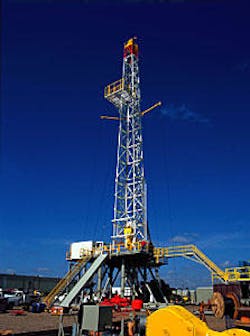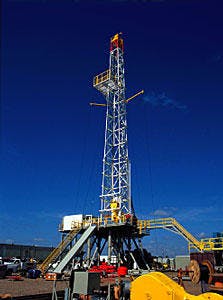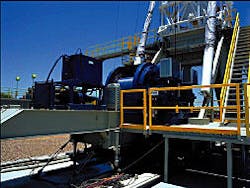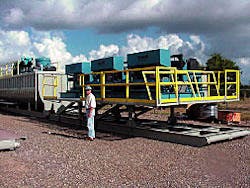Pioneer land rig with AC drawworks spuds first well
In August, Pioneer Drilling Co. Ltd., San Antonio, mobilized the first of two new IRI 1700E series rigs built by National Oilwell Inc., Houston (Fig. 1). The 1,700 hp Rig No. 7 spudded its first well, the Leonard Haynes No. 66, in Zapata County, Tex. for Pogo Producing Co., Houston.
Pioneer's second rig (No. 8), currently under construction in National's Corpus Christi yard, is scheduled for completion and delivery at the end of September. Pioneer currently holds a contract with Devon Energy Corp. for the rig.
Rig No. 7, rated to 18,000 ft, comes with a number of improvements to make it one of the most efficient and advanced land rigs available.
It has a newly designed mud system, climate-controlled driller's cabin, system controls connected through programmable logic controllers and fiber optic cabling, and other overall designs to enhance modularity and mobility.
Drawworks
Pioneer's rig No. 7 is the first US land rig to use AC drive motor drawworks, which have been used offshore for many years. The AC motor single-speed system allows better control and can hold full load at zero speed.
Regenerative braking through the AC motor eliminates the need for an auxiliary brake, allowing less weight and smaller footprint (Fig. 2).
Because of the AC drawworks, the rig requires fewer engines, thereby reducing maintenance requirements, increasing fuel economy, and lowering operating costs.
The AC technology allows greater control of the drilling process and improves efficiency during tripping operations.
Substructure, derrick
Pioneer Rig No. 7 was built around National Oilwell's IRI mobile drilling rig design, which has been supplied to most of the recent newbuilds in the industry. National built both the substructure and derrick with telescoping designs to increase modularity and ease of rig up, thus reducing the number of loads required to move the rig.
The substructure has cylindrical legs, which telescope from 11 ft, 4 in. to 22 ft. It is rated for 1,135,000-lb load capacity and can be moved in two loads, compared to four-six loads for conventional substructures.
The substructure is pinned together at ground level and raised to working position with hydraulic cylinders, within the substructure legs. After raising the substructure, crews install diagonal supports.
The derrick is a 136-ft telescoping mast that is moved in one load, compared to three or four loads for conventional derricks.
Once the derrick is moved to the substructure but before being up righted, the derrick is telescoped to full height and pinned.
Two mast-positioning-and-raising hydraulic rams then move the base of the derrick up to the rig floor or top of the substructure. Crews then reposition the hydraulic rams, so that they can raise the derrick.
Mud system
The mud system employs three Brandt LPC-40 shale shakers, developed in the North Sea, to provide high solids-control efficiency, reducing drilling fluid, pump, and bit costs.
The shale shakers sit on a skid that has a cantilever rig-up system, eliminating the need for a crane (Fig. 3).
The rectangular tanks have rounded bottoms to eliminate corners and sides that create dead spaces in conventional tanks. The design prevents mud solids from accumulating in the bottom and corners of the tanks and eliminates the need for mud guns.
Crews have easy access to the specially designed valves, piping, and drain lines, for operation and maintenance of the system. Pioneer equipped the rig with two Continental Emsco FB-1 600 triplex mud pumps.
Control system
The driller occupies a single-seat climate-controlled cabin near the rig floor where he controls the drawworks, rotary table, mudpumps, and rig power plants, using touch-screen computer controls and a joystick.
The system employs programmable logic circuits and fiber optic cabling, to provide control to the rig as well as real-time data for analysis, trending, processing, and graphical display.
An automatic driller performs the often-monotonous task of monitoring and adjusting weight-on-bit to optimizing drilling efficiency.
As a package, Pioneer Rig No.7 requires a smaller well location than conventional rigs with the same capability. Pioneer crews can move the rig in about 20 loads, compared to 30 loads for a more conventional rig. Crews require no crane to rig up or rig down.



